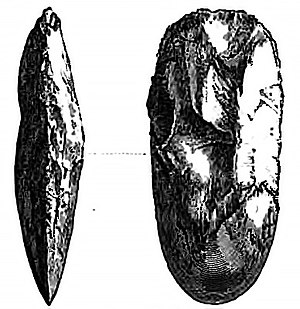which is ground and highly polished. The stone resembles hornfels, and is, in all probability, a water-worn fragment of metamorphic rock from the near neighbourhood of granite. This axe was much admired by Wye-wye-a-nine, who, when he saw it, said—Tal-kook—very good. Its weight is one pound three ounces and a quarter; and, when fitted with a good handle, it must have been a most excellent implement.

|
| FIG. 197.–(Scale ⅓.) |
A large stone tomahawk, in the possession of Mr. G. C. Darbyshire, which he has permitted me to examine and figure for this work (Fig. 197), is, it is believed, from the Darling district. It has been formed by striking off flakes, and the skill and precision with which this has been done cannot be properly represented by any drawing. It is a beautiful implement, with a highly-polished and very sharp cutting edge. The gum used in fixing the handle still adheres to it, and the stone is not in the least decomposed in any part. The material is a dense dark-green quartzite, resembling hornstone. It is seven inches in length, three inches and a quarter in breadth, and the greatest thickness is one inch and a half. It weighs one pound nine ounces and three-quarters. Though it may be said that this axe is roughly hewn, the blows have been given with so much precision as to excite surprise, having regard to the material of which it is composed. With all the help of good tools, I question whether any European could make a better axe if he had a rough block of quartzite given to him for the experiment.
When I was at Mr. Fehan's out-station on the River Powlett, I asked the manager, Mr. Bees, whether any stone implements had been found in the district, and on his informing me that some had been turned up in digging the garden (a piece of land about a quarter of an acre in extent, and having a steep slope towards the river), I wrote to Mr. Fehan asking him to procure, if possible, any specimens of this kind. He replied promptly and courteously, and sent me five stone axes, all of which, I understand, had been found in the garden. The area now known as the Wild Cattle Run must have been, in past times, a favorite resort of the natives. It was probably debatable land, and certainly, if the oldest accounts given by the natives are to be trusted, the scene of many battles between the Western Port blacks and the tribes of South-Western Gippsland. In these encounters it is not unlikely that implements were often lost, but still it is remarkable that so many as five stone axes should have been found in digging up the surface of a small area.
One of the axes is evidently very ancient. It has been split in using it, and then thrown away. It has lain so long in the ground that it is now pitted all over, both on the polished side and on that which has been broken. It is a
